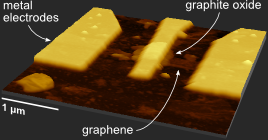
Brian Standley
I earned a PhD from Caltech in the Applied Physics option, working on carbon nanoelectronics in Marc Bockrath's group at UC Riverside. I attended the University of Idaho from 2000-2004, obtaining a B.S. Electrical Engineering while completing internships at Micron in Boise, ID.
In my free time I go on adventures with my wife Eve Stenson, including activities such as downhill skiing, backpacking, motorcycling, and SCUBA diving. See more photos here and here. I have also spent time working with Arch Linux and the C programming language.
Research

Atomic-scale switching in graphene nanogaps
Over the last number of years, graphene has been the focus of intense research into its electronic, mechanical, and chemical properties, especially as they relate to logic circuit applications. While much of this effort has focused on transistor-like devices, non-volatile memory elements are needed as well. I (along with collaborators) discovered a way to make and operate an example of the latter:
| 1. | Fabricate a standard two-terminal one-to-few-layer graphene device on a Si/SiO2 chip. |
| 2. | Use an electromigration-like technique to create a nanometer-scale gap in the graphene channel.1 |
| 3. | Create and/or destroy conducting channels across the gap using volt-scale pulses. |
| 4. | Read out the logical state by measuring the low-bias resistance. |
Steps 3 and 4 can be repeated at least ~104 times without degrading the device. The conducting channels are thought to be linear chains of carbon atoms "unzipped" from the edges of the graphene sheets, as described in Rinzler et al and Lang et al. For more information, see the link to the paper below.

Graphite oxide gate dielectric
Graphite oxide (GO) has generated interest in a wide array of fields – from supercapacitors to electronics to nano-paper. I (with collaborators) worked to make a top-gated graphene field-effect transistor using GO as the gate dielectric, rather than boron nitride or various bulk insulators such as SiO2 or HfO2 as had been done before. Such devices show little gate leakage current (even at room temperature) and a breakdown field comparable to SiO2. Alas, the material's relative dielectric constant (κ) appears to be only slightly higher than SiO2 ~ 4.3.
GO's utility for graphene electronics is of particular interest because both graphite oxide and graphene are layered materials. In addition, GO can be made directly from graphene in various ways. One might imagine turning an n-layer stack of graphene sheets into self-aligned a n-m layer graphene + m layer graphite oxide device, or using layer transfer to make more complicated stacks.2 For for information, see the link to the paper below.
| 1 | The physics is a bit different from actual electromigration (i.e. in metals) because, being covalently bonded, the carbon atoms in graphene stay roughly in place until those in the hottest region abruptly "vaporize." | |
| 2 | The devices used in this work were made by random solution-phase deposition of GO onto mechanically exfoliated graphene. | |
Software
Mezurit 2

Scriptable continuous and triggered data acquisition for Linux and Windows
As nanoelectronics experiments and associated instrumentation continue to grow in complexity, the need for powerful data acquisition software has only increased. This role has traditionally been filled by all-in-one devices such as semiconductor parameter analyzers (SPAs) or by stand-alone desktop computers running National Instruments LabVIEW. Mezurit 2 represents a hybrid approach, combining the ease-of-use of SPAs with some of the flexibility of LabVIEW. It can control multiple inputs and outputs in real time while simultaneously plotting data and executing Python-based scripts.
For more information, or to download the source code, visit the project page.
Utilities
awcgen - A Perl script to generate AWC-compatible waveforms for the SRS DS345 Function Generator.
npgsfixer - A Perl script to modify DesignCAD files imported from DXF to work with NPGS. Also fractures patterns.
Hardware
80 V Bipolar Gate Voltage Amplifier
Sometime you need more than 10 V to characterize semiconductors (especially graphene-based devices). Thus, the BGVA is a two-stage 10X voltage amplifier capable of smoothly sweeping from -80 to 80 V. It is powered by isolated DC/DC converters which are easily stacked to achieve the necessary supply voltages. As a bonus, this design eliminates a potential ground loop on the power supply side.
For more information, see its "datasheet." Right now only the prototype exists, but addition copies could be made fairly inexpensively if there is interest.
Papers
- B. Standley, W. Bao, H. Zhang, J. Bruck, C. N. Lau, and M. Bockrath, "Graphene-Based Atomic-Scale Switches",
Nano Letters 8, 3345-3349 (2008). - N.-C. Yeh, M. Teague, R. Wu, S. Yeom, B. Standley, D. Boyd, and M. Bockrath, "Nano-Scale Strain-Induced Giant Pseudo-Magnetic Fields and Charging Effects in CVD-Grown Graphene on Copper",
ECS Transactions 35, 161-172 (2011). - N.-C. Yeh, M. Teague, S. Yeom, B. Standley, R. Wu, D. Boyd, and M. Bockrath, "Strain-induced pseudo-magnetic fields and charging effects on CVD-grown graphene",
Surface Science 605, 1649-1656 (2011). - W. Bao, L. Jing, J. Velasco Jr., Y. Lee, G. Liu, D. Tran, B. Standley, M. Aykol, S. B. Cronin, D. Smirnov, M. Koshino, E. McCann, M. Bockrath, and C. N. Lau, "Stacking-dependent band gap and quantum transport in trilayer graphene",
Nature Physics 7, 948-952 (2011). - B. Standley, A. Mendez, E. Schmidgall, and M. Bockrath, "Graphene-Graphite Oxide Field-Effect Transistors",
Nano Letters 12, 1165-1169 (2012). - H. Zhang, W. Bao, Z. Zhao, J. W. Huang, B. Standley, G. Liu, F. Wang, P. Kratz, M. Bockrath, and C. N. Lau, "Visualizing Electrical Breakdown and ON/OFF States in Electrically Switchable Suspended Graphene Break Junctions",
Nano Letters 12, 1772-1775 (2012). - W. Bao, J. Velasco Jr., F. Zhang, L. Jing, B. Standley, D. Smirnov, M. Bockrath, A. MacDonald, and C. N. Lau, "Evidence for a spontaneous gapped state in ultraclean bilayer graphene",
PNAS 109, 10802-10805 (2012).
Old stuff
- After I got married in March 2009, we kept the wedding webpage around for archival purposes (and to serve any time-travelling guests).
- Class webpage for Caltech APh 77 - Laboratory in Applied Physics (Spring 2005)
Contact info
| Email: | brian@brianstandley.com |
| Phone: | +1 208 906 2640 / +49 0176 9997 2258 |
| PGP key: | 0x7E7B0AE8 |